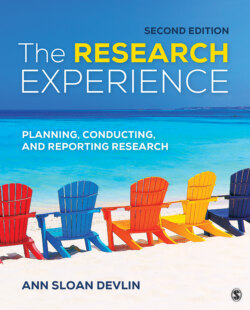Читать книгу The Research Experience - Ann Sloan Devlin - Страница 117
Try This Now 3.1
ОглавлениеList another variable that might be used to help explain this significant relationship between students’ GPAs and the distance of the college from their hometowns.
Perhaps you said, “attended boarding school.” Perhaps going to boarding school prepares you for attending college a far distance from home, and it is this boarding school preparation, not the distance from home itself, that better explains this relationship with GPA. The essence of research in which causality can be inferred is control—control over every aspect of the research endeavor that can be controlled. When control is not possible, we have other ways we try to spread out the variability or differences in humans that can interfere with the factors we are studying. For example, when we do a study where people are exposed to different stimuli (e.g., pictures of natural and built environments) to measure environmental preference (i.e., how much they prefer particular environments), we randomly assign the participants to the different pictures (i.e., conditions) to spread out or distribute the variability that exists in the population (our participants). We do this random distribution to try to make sure, for example, that all the environmental studies majors don’t end up in the condition with pictures of nature! If they did, a higher preference for pictures of the natural environment might be explained by the students’ major, not by qualities depicted in the pictures themselves.
When we make a statement about causality, we have to persuade our audience that there are no other likely explanations; we have to rule out what are known as alternative variables represented by unmeasured or third variables, which was discussed at the end of Chapter 2. In correlational studies, such variables may lead us to infer incorrectly relationships between our variables of interest when, in fact, it is the third variable at work. Excerpts from a wonderful video from Frans de Waal’s TED Talk, “Moral Behavior in Animals,” show what happens when two capuchin monkeys were rewarded unequally for the same “work” and the less-well-rewarded monkey tests out an alternative explanation (https://www.youtube.com/watch?v=meiU6TxysCg).
One monkey is rewarded with a grape (the preferred food); the other monkey is rewarded with a piece of cucumber for the same task (handing a small stone to the experimenter). When this happens, the monkey that received the cucumber is quite unhappy (throwing the cucumber back at the researcher) and next tests a stone against the side of the cage to make sure that the stone hasn’t somehow produced the inequitable result. What this monkey is doing is testing for a third variable, as if to say, “maybe it’s the stone that’s the problem.” Even capuchin monkeys are capable of thinking about alternative explanations!
Combing two previous examples, how might you infer causality in a study involving distance and working out? In the earlier example, we could not randomly assign people to their hometowns, but we might be able to assign first-year students randomly to residence halls at different distances from the campus fitness center. Then our research question might be whether living closer to the fitness center has an effect on the number of times a week students go to the center to work out. There are many other variables (representing alternative explanations; see Chapter 2) that we might need to rule out (whether the student is a varsity or club athlete, any health restrictions, athlete status in high school, and so on), but we have manipulated and controlled a variable (distance from the fitness center) and randomly assigned people to the conditions (different residence halls located at different distances from the fitness center). If there is a result showing that people who live closer to the fitness center work out more times per week than do those who live farther from the fitness center, then we might infer causality related to the variable of distance.
